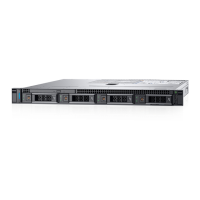Power indicator codes Condition
CAUTION: If two PSUs are installed, both the PSUs must have the same type of label; for
example, Extended Power Performance (EPP) label. Mixing PSUs from previous generations of
PowerEdge servers is not supported, even if the PSUs have the same power rating. This results
in a PSU mismatch condition or failure to power on the system.
CAUTION: When correcting a PSU mismatch, replace only the PSU with the blinking indicator.
Swapping the PSU to make a matched pair can result in an error condition and unexpected
system shutdown. To change from a high output conguration to a low output conguration or
vice versa, you must power o the system.
CAUTION: AC PSUs support both 240 V and 120 V input voltages with the exception of Titanium
PSUs, which support only 240 V. When two identical PSUs receive dierent input voltages, they
can output dierent wattages, and trigger a mismatch.
CAUTION: If two PSUs are used, they must be of the same type and have the same maximum
output power.
Figure 147. DC PSU status indicator
1
DC PSU status indicator
Table 46. DC PSU status indicator codes
Power indicator codes Condition
Green A valid power source is connected to the PSU, and the PSU is
operational.
Blinking amber Indicates a problem with the PSU.
Not illuminated Power is not connected to the PSU.
Blinking green When hot-plugging a PSU, the PSU indicator blinks green. This
indicates that there is a PSU mismatch about eciency, feature set,
health status, or supported voltage.
190 System diagnostics and indicator codes

